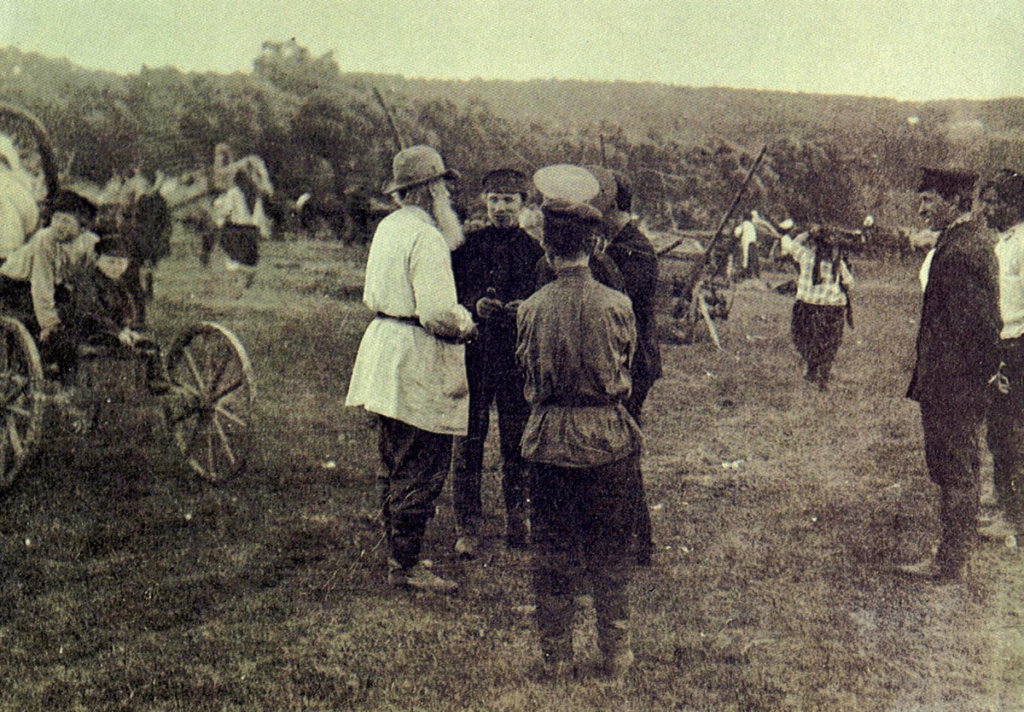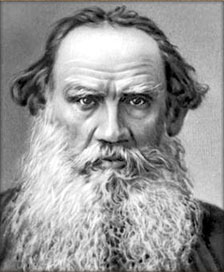Stories From Physics, Leo Tolstoy

Stories From Physics
Translated by Nathan Haskell Dole 1888
Chapter I
THE MAGNET
IN days of old there was a shepherd whose name was Magnis. One of Magnis’s sheep went astray. He went to the mountains to search for it.
He reached a spot where there were only bare rocks. As he walked over these rocks he began to be conscious that his boots were adhering to them. He felt of them with his hand; the rocks were dry, and did not stick to his hands. He started to walk on again; still his boots stuck fast.
He sat down, took off one of his boots, and holding it in his hands, began to touch the rocks with it.
When he touched them with the leather or the sole, it did not adhere; but when he touched them with the nails, then it adhered.
Magnis had a crook with an iron point. He touched the stones with the wood, it did not adhere; but when he touched it with the iron, it clung so powerfully that he had to pull it away by main force.
When Magnis examined the stone, he’ saw that it was like iron, and he carried some of the pieces of rock home with him. From that time they understood this stone, and called it lodestone, or magnet.
Magnets are found in the ground, together with iron ore. The best iron is found when the ore contains lodestone.
If a piece of iron is put on the magnet, then the iron also begins to attract other pieces of iron. And if a steel needle is laid on a magnet and kept there for some time, then the needle itself becomes a magnet, and is able to attract iron to itself.
If two magnets are laid side by side, two of the ends or poles will repel each other; the other two will attract each other. If a magnetic needle be broken in two, then again each half will attract at one pole and repel at the other. And if it be broken again, the same thing will happen; and no matter how many times it is broken, it will be always the same like poles repelling one another, unlike poles attracting one another; just as if the magnet pushed with one end and pulled with the other.
And, however often you break it, one pole will always push and the other draw.
It is exactly like a pine cone : no matter where it is broken off, one end is always convex, the other hollow. And if they are put end to end, the convex fits into the hollow; but the convex will not fit the convex, nor the cup the cup.
If a needle is magnetized by being left some time in contact with a magnet, and is balanced on a point in such a way that it will move freely on the point, then no matter in which direction the magnetic needle is turned, as soon as it is set free, it will come to rest with one pole pointing to the south, the other pointing to the north.
Before the magnet was discovered men did not dare to sail very far out on the sea. Whenever they sailed out of sight of land, then they could judge only by the sun and the stars where they were going. But if it was stormy, and the sun and stars were hid, then they had no way of telling where their course lay; and the vessel would drift before the wind, and be dashed on the rocks and go to pieces.
Until the discovery of the magnet they did not sail on the ocean far from land; but after it was discovered, then they made use of the magnetic needle balanced on the point so as to turn freely. By means of this needle they could tell in which direction they were sailing. With the magnetic needle they began to make long voyages far from land, and afterward they discovered many new countries.
There is always on board ship a magnetic needle, called the compass, and they have a measuring-line with knots, at the stern of the ship. And the cord is so constructed that it uncoils and tells how fast the vessel is sailing.
Thus it is that, when they sail a ship, they always know where they are at any given time, and whether they are far from land, and in what direction they are going.
Chapter II
HUMIDITY
WHY does the spider sometimes make a closely spun web and sit in the very center of its nest, and why does it sometimes come out of its nest and spin a new web ?
The spider makes its web according as the weather is at the time, and as it is going to be. By examining its web one can predict what the weather will be; if the spider hides itself away deep down in its nest and does not come out, it means rain. If it emerges from its nest and spins new threads, it means that it will be fine.
How can the spider tell in advance what the weather will be ?
Its sensibilities are so delicate that as soon as the atmosphere begins to have greater humidity, even though this humidity is not perceptible to us, and to us the weather is still clear, the spider perceives that rain is coming. Just as a man feels the dampness when he is undressed, but does not feel it when he is dressed, so the rain is perceptible to the spider when for us it is only preparing to rain.
Why is it that in winter doors swell and refuse to shut, but in summer they dry up and shrink ?
Because in autumn and winter the wood absorbs moisture like a sponge, and swells; but in summer the water evaporates and the wood shrinks.
Why does a soft wood like poplar swell more than oak, for example ?
Because in the hard wood, in the oak, there are less empty spaces, and less room for the water to sink in; while in the soft wood, in the poplar, there are more empty spaces and more room for the water. In decay-ing wood there is still more room and therefore decayed wood swells more than any other kind and sinks sooner.
Beehives are made of the softest wood or of rotten wood; the best hives are made of rotten willow. Why ? Because the air penetrates the rotten stump, and bees like the air in this kind of a hive.
Why do boards warp ?
Because they dry unevenly. If you put a damp board into an oven, the water exudes from one side, and the board gets dry on that side and makes the other side yield to it. It is impossible to shrink the damp side be-cause there is water in it and the whole board bends.
In order to keep floors from warping, they cut out pieces of dry wood and plunge them into boiling water. When the water has been wholly boiled away the pieces are glued together and will not warp, and this kind of inlaid floor is called parket.
Chapter III
DIFFERENT DEGREES OF COHERENCE
WHY is it that the bolsters under a wagon are made of oak while the naves of the wheels are turned out of birch ?
It is necessary to have the bolsters and naves strong, but oak is not more expensive than birch. It is because oak splits lengthwise, while birch* is not easily split, but is made of tough filaments.
Accordingly, though oak has a closer texture than birch, it is so constituted that it splits, while birch is not easily split.
Why are the rims of the wheels and the bounds bent from oak or elm, but never out of birch or linden ?
Because oak and elm, when soaked and softened, become elastic and do not break, while birch and linden splinter on all sides.
All this is due to the fact that the coherence of Parti-cles in oak and birch wood differs in degree.
Chapter IV
CRYSTALS
IF salt is stirred up in water the Particles of the salt are diffused through it and become invisible, but if more and more salt is added then at last the salt ceases to dissolve, and, however much you stir it, the salt remains like a white powder at the bottom. The water had dis-solved the salt to the point of saturation and could take no more. But if the water be heated it will dissolve more; and the salt which refused to melt in the cold water will dissolve away. But if still more salt be added, then not even boiling water will dissolve it. Now, if you still continue to boil the water, the water itself will evaporate in the form of steam, and the salt will be left.
So it is of everything which water dissolves : the water has a limit beyond which it cease* to dissolve sub-stances. Everything is more readily dissolved by hot water than by cold water; but, nevertheless, when the hot water is saturated, it ceases to dissolve any more. The substance remains unchanged but the water may pass off as steam.
If powdered saltpeter is dissolved in water and then more saltpeter is added, and if the whole is heated and allowed to cool without being stirred, then the super-fluous saltpeter will not settle on the bottom in the form of a powder, but will form in clustering hexagonal prisms on the bottom and on the sides. If powdered saltpeter is dissolved in water and then put in a warm place, then the water will evaporate
